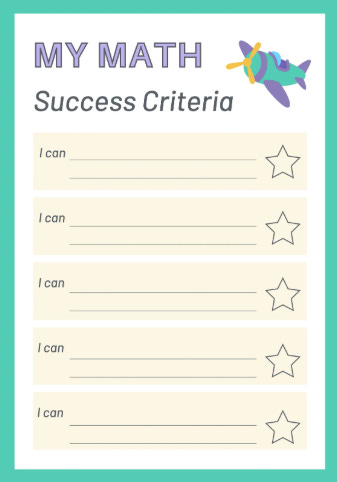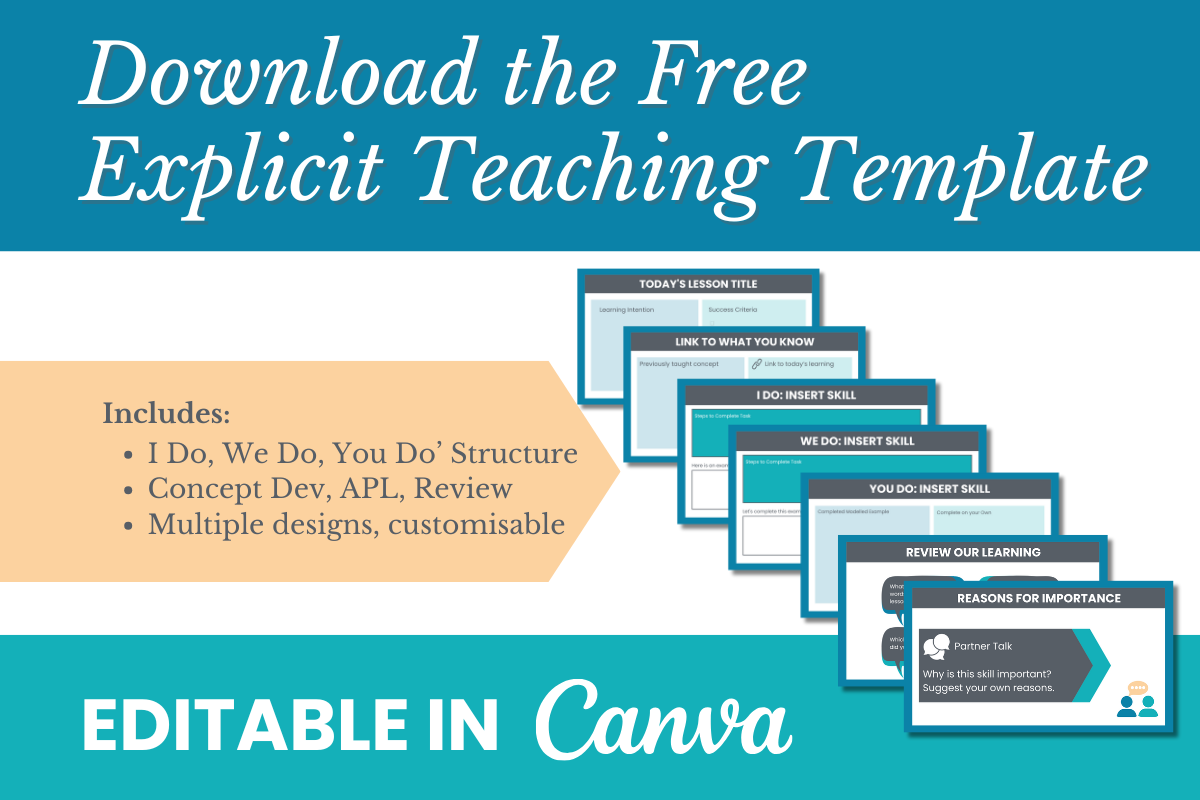How to Write Success Criteria: Clear Steps, Examples and Free Templates
Learn how to write clear, effective success criteria with step-by-step examples, teacher-friendly tips and links to free editable templates.
Success criteria are one of the most powerful parts of explicit teaching. They show students exactly what success looks like, help teachers give clearer feedback, and make learning intentions actionable. When success criteria are written well, they increase confidence, improve engagement and create measurable progress across all year levels.
In this post, we will look at:
what success criteria are
how to write success criteria step by step
examples across literacy, maths and science
the difference between learning intentions and success criteria
how to use criteria for feedback and self-assessment
where to find free editable templates
What Are Success Criteria?
Success criteria are specific, measurable statements that define what students need to achieve by the end of a lesson or activity. They outline the steps or components required to meet the learning intention, so students understand the “how” behind their objective.
Well written success criteria:
clarify expectations
break complex skills into manageable steps
give students tools to self-assess
support targeted teacher feedback
For example, if the learning intention is “Students will learn how to summarise a text”, the success criteria might include:
Identify the main ideas in the text.
Use bullet points to list key details.
Write a summary in 3 to 4 sentences using your own words.
By breaking the learning intention into actionable steps, the teacher provides a clear path to success.
If you are new to writing learning intentions, you may also like to read our How to Write Learning Intentions post.
Why Are Success Criteria Important?
Success criteria are integral to effective explicit teaching because they:
Set clear expectations
Students know exactly what they need to do and how to do it.
Support self-assessment
Students can evaluate their own work against the criteria, which fosters independence and accountability.
Guide feedback
Teachers can provide specific feedback connected to each criterion, making improvement more meaningful.
Increase motivation
When students understand what success looks like, they are more engaged and confident in their learning.
How to Write Success Criteria
Writing effective success criteria involves aligning them with the learning intention and the skills required to achieve it. Here is a step-by-step process.
1. Start With the Learning Intention
The learning intention defines the overall goal of the lesson. For example:
“Students will learn how to write a persuasive paragraph.”
2. Break the Skill Into Steps
Identify the steps required to complete the skill in the learning intention. Each step should be clear, actionable and measurable.
For the persuasive paragraph example, the success criteria might include:
Write a topic sentence that clearly states your opinion.
Include at least three supporting details or reasons.
Use linking words such as “because”, “therefore”, “for example”.
Conclude with a sentence that summarises your argument.
3. Use Specific, Measurable Language
Avoid vague statements like “Know how to” or “Understand the topic”. Focus on what students need to demonstrate.
For example:
Replace “Understand fractions” with “Identify the numerator and denominator in a fraction”.
Replace “Write a summary” with “Summarise the text in 3 to 5 sentences using key details”.
4. Align With Assessment Goals
Ensure your success criteria match the expectations of your assessment. If students will be marked on organisation, vocabulary or reasoning, include these elements in the criteria for your lessons.
5. Make Criteria Student Friendly
Write success criteria in language your students can understand. Use simple, direct phrases such as:
“I can list three causes of climate change.”
“I can solve a word problem using multiplication.”
6. Balance Specificity and Flexibility
Success criteria should be specific enough to guide performance but flexible enough to allow student voice and creativity.
For example:
“Include at least three descriptive details in your story” is specific, but students can still choose their own details.
Examples of Success Criteria by Subject
Below are sample success criteria examples you can adapt for your classroom.
Maths
Learning Intention: “Students will solve multi-step word problems.”
Success Criteria:
Read the problem and identify the question.
Highlight key information and numbers.
Write an equation to represent the problem.
Choose and use a strategy to solve the equation step by step.
Check your answer by rereading the question.
Literacy
Learning Intention: “Students will identify the theme of a story.”
Success Criteria:
Identify the main character’s actions and motivations.
Describe the problem or conflict in the story.
Explain how the problem was resolved.
Write a sentence that summarises the theme.
Science
Learning Intention: “Students will draw and label a diagram of the water cycle.”
Success Criteria:
Define key terms such as evaporation, condensation and precipitation.
Draw and label a diagram of the water cycle.
Explain how water moves through each stage in 1 to 2 sentences.
Tips for Implementing Success Criteria
1. Introduce Success Criteria at the Start of the Lesson
Begin each lesson by clearly explaining the success criteria. Use visuals or examples to ensure students understand what they need to do.
You can find FREE success criteria posters posters here.
2. Refer Back to Criteria During the Lesson
Throughout the lesson, remind students of the success criteria. For example:
"Before you start writing, check that your topic sentence states your opinion."
"Does your solution include all the steps we discussed?"
3. Use Success Criteria for Feedback
When providing feedback, reference the success criteria to show students what they did well and where they can improve. For example:
"Your diagram is clear and accurate, but make sure you include labels for all the stages."
Download and use these feedback slips for free.
👉Find more Feedback Templates here
4. Encourage Self-Assessment
Provide students with a checklist based on the success criteria. This helps them reflect on their progress and identify areas for improvement.
5. Review Criteria at the End of the Lesson
Conclude the lesson by revisiting the lesson criteria. Discuss with students whether they met the expectations and what they learned.
Common Pitfalls and How to Avoid Them
Too Vague: Avoid generic criteria like "Know" or "Understand the topic." Focus on specific, observable actions.
Too Broad: Break down complex skills into manageable steps.
Not Aligned with the Lesson: Ensure learning targets directly reflect the learning intention and assessment goals.
Supporting Resources
Explore free editable templates to support your success criteria planning.
Click the image to access these editable Canva templates for free:
FAQ: Success Criteria in Explicit Teaching
What is the difference between learning intentions and success criteria?
Learning intentions describe what students are learning. Success criteria describe what it looks like when they have achieved it.
How many success criteria should I include?
Enough to break down the skill clearly, without overwhelming students. Often three to five well written criteria are sufficient.
Should students help write success criteria?
Where appropriate, co-constructing success criteria can build ownership and understanding. You might model criteria for the first few lessons, then gradually invite student input.
Can success criteria be used in every subject?
Yes. Success criteria are effective in any subject where you want to clarify expectations and support students to demonstrate learning.
What to Read Next
You may also find these posts helpful:
Having clear success criteria before starting any lesson is essential. They help teachers set explicit goals for students and provide measurable benchmarks to evaluate learning outcomes. By prioritising success criteria, educators can create structured, focused and impactful lessons.
Brolga Education
Created by Trudy Mayo — explicit teaching specialist & curriculum writer.
💌 New here? 📚 Follow on Instagram for daily tips & behind-the-scenes: @brolgaeducation











